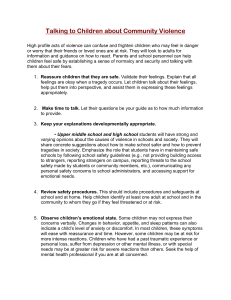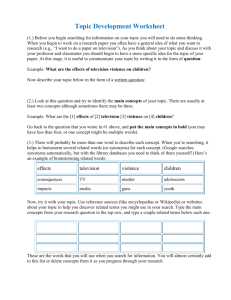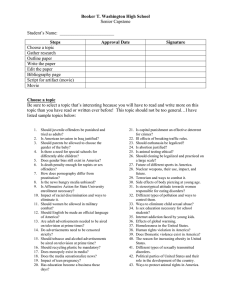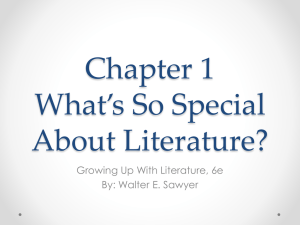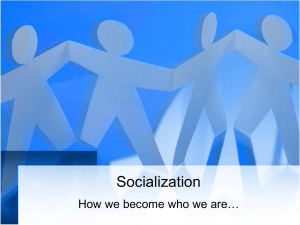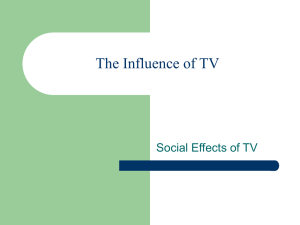media and children take home final
advertisement
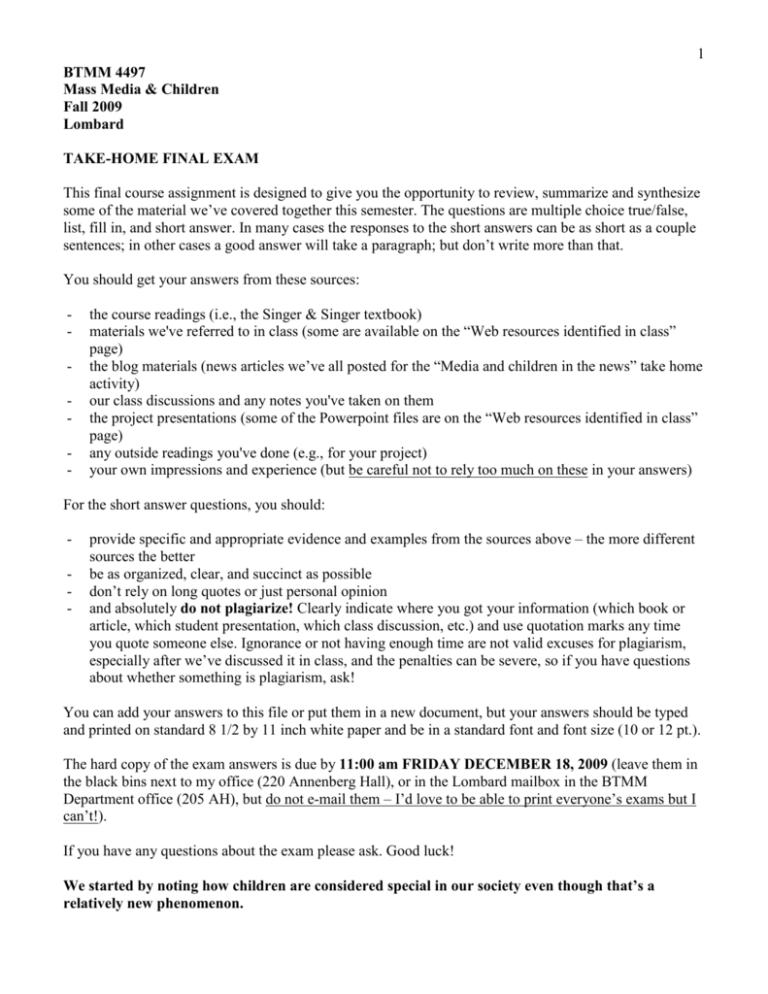
1 BTMM 4497 Mass Media & Children Fall 2009 Lombard TAKE-HOME FINAL EXAM This final course assignment is designed to give you the opportunity to review, summarize and synthesize some of the material we’ve covered together this semester. The questions are multiple choice true/false, list, fill in, and short answer. In many cases the responses to the short answers can be as short as a couple sentences; in other cases a good answer will take a paragraph; but don’t write more than that. You should get your answers from these sources: - the course readings (i.e., the Singer & Singer textbook) materials we've referred to in class (some are available on the “Web resources identified in class” page) the blog materials (news articles we’ve all posted for the “Media and children in the news” take home activity) our class discussions and any notes you've taken on them the project presentations (some of the Powerpoint files are on the “Web resources identified in class” page) any outside readings you've done (e.g., for your project) your own impressions and experience (but be careful not to rely too much on these in your answers) For the short answer questions, you should: - provide specific and appropriate evidence and examples from the sources above – the more different sources the better be as organized, clear, and succinct as possible don’t rely on long quotes or just personal opinion and absolutely do not plagiarize! Clearly indicate where you got your information (which book or article, which student presentation, which class discussion, etc.) and use quotation marks any time you quote someone else. Ignorance or not having enough time are not valid excuses for plagiarism, especially after we’ve discussed it in class, and the penalties can be severe, so if you have questions about whether something is plagiarism, ask! You can add your answers to this file or put them in a new document, but your answers should be typed and printed on standard 8 1/2 by 11 inch white paper and be in a standard font and font size (10 or 12 pt.). The hard copy of the exam answers is due by 11:00 am FRIDAY DECEMBER 18, 2009 (leave them in the black bins next to my office (220 Annenberg Hall), or in the Lombard mailbox in the BTMM Department office (205 AH), but do not e-mail them – I’d love to be able to print everyone’s exams but I can’t!). If you have any questions about the exam please ask. Good luck! We started by noting how children are considered special in our society even though that’s a relatively new phenomenon. 2 1. LIST: Identify eight (8) examples (we came up with tons in class) of how our society treats children not just as “little adults” and workers but as "special," a "separate class" from adults, the "promise of the future," etc. 1. ____________________________ 2. ____________________________ 3. ____________________________ 4. ____________________________ 5. ____________________________ 6. ____________________________ 7. ____________________________ 8. ____________________________ Then we discussed aspects of child development. We watched an old Prime-Time Live report about a woman who had been misdiagnosed as having mental disabilities when she was actually deaf and how her early language deficits couldn’t be made up; we looked at various web resources that feature timelines of development from the womb to adulthood; and we discussed some major theories and theorists regarding cognitive development (perception, memory, reasoning, problemsolving), social and emotional development, and moral development). 2. FILL IN: There are three big categories of debate in child development theories: The first is about how much is "pre-programmed,” whether nature or _________ is more important. The second is about whether development is passive, something that happens to children regardless of what they do, or it is _________, something that they help determine by what they do. And the third debate is about whether development is continuous or happens in _________. 3. SHORT ANSWER: Which of the two groups of theorists below takes a mechanistic approach in their theories and which group takes an organismic approach, and what’s the difference? Group 1: Watson, Skinner, Hull, Bandura Group 2: Piaget, Freud, Erickson Next we characterized the media environment available to children today, sharing examples and impressions from the first take-home activity in which you each explored one part of the media targeted toward children. 4. SHORT ANSWER: In general, how are children’s media (media designed for children, not media intended for adults that children may be exposed to) different from adults’ media in terms of their form and in terms of their content? 5. SHORT ANSWER: What percentage (i.e., from 0% to 100%) of all this media material designed for children do you believe is generally good for them and what percentage has no effect or is harmful (provide some evidence and/or examples to back up your answer)? We also discussed media use patterns and habits among children. 6. SHORT ANSWER: Using the chart we created in class, information in the readings and online, and your best guess as a media studies expert, for about how many hours a day is a typical 10 year old middle class child exposed to media today? Explain how you came up with your answer. 3 Next we talked about children’s media industries and the policies and regulations that they are subject to. We illustrated some of them with a business proposal competition (the winner was the Healthy Heather and Hal by Kali, Arielle and Raython). 7. Individuals and companies planning to produce and distribute media products for children are expected to follow the rules set out by all but which one of the following? a. Children’s Advertising Review Unit of the National Council of Better Business Bureaus b. Children’s Television Act of 1990 c. Telecommunications Act of 1996 d. Child Online Protection Act of 1998 Then we discussed a variety of media and children topics Children, reality distinctions and telepresence – Matthew L. 8. FILL-IN: Young children have to learn to make three kinds of reality distinctions: 1. _____________ vs _____________ 2. _____________ vs _____________ 3. _____________ vs _____________ 9. SHORT ANSWER: What is telepresence? Violence (Ch. 11 [+10, 12]) – Matt and John M. 10. LIST: Identify three media-related factors that many newscasters and television personalities claimed influenced the shooters following the school shootings at Columbine High School in April of 1999. 1. ________________________ 2. ________________________ 3. ________________________ 11. TRUE or FALSE? The top seven best selling videogames for Xbox 360 are driven by violence as their main theme. 12. What does most of the research evidence suggest about the effects of media violence? a. It’s one cause of real world violence b. It has no effect c. It’s the primary cause of real world violence d. It affects some people under some circumstances e. A and D Gender (Ch. 17) - Alyson 13. TRUE or FALSE? A person’ s gender is their genetically determined biology while their sex refers to a variety of traits associated with each gender. 4 14. SHORT ANSWER: Alyson presented examples of commercials that target boys and that target girls – how were the two sets of ads different? Race, ethnicity and culture (Ch. 18) - Noelle 15. TRUE or FALSE? In the early days of television, situation comedies featuring minority group characters included many stereotypes, but starting with The Cosby Show, the portrayals in these programs have all been accurate and positive. 16. SHORT ANSWER: What are the potential negative effects of family programs like situation comedies that feature negative portrayals of members of minority groups? [see Noelle’s ppt] Advertising and consumerism (Ch. 19) - Kali and Arielle 17. TRUE or FALSE? Children are exposed to over 40,000 ads per year just on television. 18. Which product often targeted towards children in television advertising did Kali and Arielle talk about in their presentations? a. Candy bars b. Sugary cereal c. Cookies d. Cars 19. TRUE or FALSE: It’s not until about age 8 that children understand the difference between reality and a commercials and that a commercial is trying to sell them something. Learning and prosocial effects (Ch. 5 [+7-9]) – Becky 20. SHORT ANSWER: Identify 3 examples of the kinds of prosocial television programs Becky told us about and explain what makes each one prosocial. Media advocacy and intervention strategies (Ch. 37 [+38-39]) - Kevin 21. LIST: Name three things parents and other caregivers can do to improve their children’s experience with media and the effects of media on them. 1. ______________________________________________________________ 2. ______________________________________________________________ 3. ______________________________________________________________ 22. TRUE or FALSE? Media advocacy is what groups do to bring media attention to particular public issues and expose what they consider harmful practices and behaviors, by creating events and/or buying media time. 5 23. Which one of these is an example of media advocacy? a. Verizon’s FIOS campaign b. Tobacco kills. Don't be duped. c. Collingswood Night at the Phillies d. Temple University’s 125th anniversary campaign Family interaction and social relationships (Ch. 16) – Rathon and Hannah 24. TRUE or FALSE? Media have an important role in forming relationships in families, but since radio is not visual at all but all audio, it has less impact on family interaction than any other medium. 25. SHORT ANSWER: In what ways do cell phones affect the relationships of children with each other and their families and friends? Morality (Ch. 23) - Lisa 26. FILL IN: Kohlberg’s 3 levels of moral development are ________________, __________________, and _______________. 27. SHORT ANSWER: How do media, especially entertainment media in the post 9/11 era, teach children (and all of us) who are the ‘good guys’ and the ‘bad guys’? (see the youtube video in Lisa’s presentation) Political Socialization – Kira and Joe 28. SHORT ANSWER: What is political socialization? 29. Which of the following theories is associated with political socialization? a. Cultiviation theory b. Learning theory c. Social penetration theory d. Mass communication theory Sexuality (Ch. 13 [+14]) - Melanie and Raquel 30. TRUE or FALSE? The majority of sexual content in the media contains messages about sexual risk and responsibility. 31. When asked where they learned the most about sex, younger adolescents 13 to 15 years old rank mass media behind: a. Parents b. Friends c. Schools d. All of the above e. None of the above 6 Health: Drugs and nutrition (Chs. 21 and 22) – James A. and Sam 32. In a study conducted by the Which? Company, 19 cartoon characters were identified in stores as being used to sell food products to children. Of the 19, how many of the cartoon characters were used to sell healthy food? a. 7 b. 4 c. 2 d. 0 33. In the episode of Tiny Toons where the characters become involved in drinking and driving, what is the end consequence? a. The characters are taken to jail. b. The characters are pulled over by a cop who takes their beer and drives away. c. The characters die and are buried. Their teachers and friend mourn their untimely deaths. d. The characters die and ascend to heaven. They proceed to take off their angel costumes and walk out of the TV studio unscathed. Music lyrics and videos (Ch. 20) – Lauren 34. TRUE or FALSE? According to some studies, teens who listen to sexually explicit music are more likely to have sex earlier. 35. LIST: Name 3 things that can be done to monitor children listening to sexually explicit music. 1. ____________________________________________________ 2. ____________________________________________________ 3. ____________________________________________________ 36. TRUE or FALSE? Teens emulate the behavior they see in music videos. Video games – James D. 37. TRUE or FALSE? In addition to learning how to play and win a video game, users experience tangential learning, the learning of things unrelated to the main activity of the game. 38. TRUE or FALSE? The research evidence consistently supports Catharsis Theory, which holds that people become less violent after using violent media because they get an emotional release from it. Wrap up 39. We’re expanding the Top 10 Big Ideas of the class to include the topics you presented and helped us discuss – what is the single most important big idea (no more than 2 sentences long!) that you learned and that you’d like the rest of us to remember from your project? That’s it – have a great holiday!!

